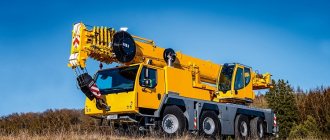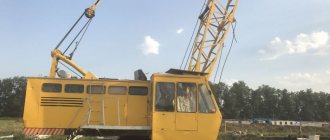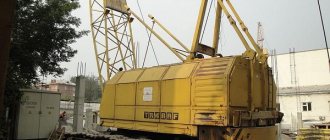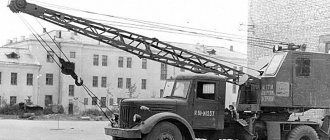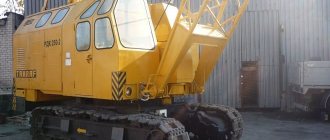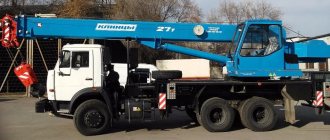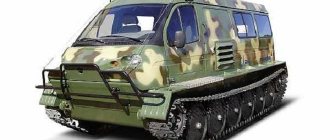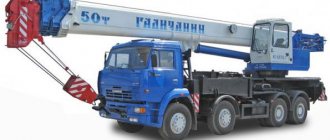Specifications
The RDK-250 crane has a standard boom length of 12.5 meters. To ensure work safety, a specialized system is installed that prevents overload and the risk of the crane overturning, as well as controls dangerous approach to power line supports.
The main technical characteristics of the RDK-25 (RDK-250) crawler crane are considered in the table:
| Characteristics | Indicators |
| Main boom length, m | 12,5 |
| Maximum boom length, m | 35,2 |
| Rigid jib length, m | 5 |
| Minimum reach, m | 1,75 |
| Maximum reach (with main boom), m | 13,6 |
| Mast length (tower-boom version), m | 12,5 — 27,5 |
| Length of the steerable jib, m | 10; 15; 20 |
| Load capacity at minimum reach, t | 25 |
| Load capacity at maximum reach, t | 3,6 |
| Load capacity of auxiliary lift, t | 5 |
| Maximum load moment, t*m | 100 |
| Lifting height at minimum reach (main hook), m | 12,4 |
| Lifting height at maximum reach (main hook), m | 7 |
| Lifting height at minimum reach (auxiliary hook), m | 15,7 |
| Lifting height at maximum reach (auxiliary hook), m | 6 |
| Weight with main boom, t | 45,2 |
| Average ground pressure, MPa | 0,085 |
| Electric motor power, kW | 75 |
| Overall dimensions (without boom), mm | 3225x6300x4300 |
Power point
As modernization progressed, different models of water-cooled diesel engines were installed on the crane; the main characteristics of these engines are shown in the table.
| Engine | A01-ME | D-108 | D-440 |
| Crane modifications | RDK 250, RDK - 250-1 | RDK 250-1, RDK 250-2 | RDK 250-3, RDK 250-4 |
| Number of cylinders | 6 | 4 | 4 |
| Working volume, l | 11,5 | — | — |
| Power, hp | 130 | 108 | 98 |
| Method of mixture formation | direct injection | ||
| Nominal rotation speed, rpm | 1500 | 1140 | 1750 |
| Max. torque, N.m | 683 | 750 | 533 |
| Specific fuel consumption, g/hp. *h | 167 | 175 | 168 |
Working speed
Rotation of the full-rotation crane platform with a load is possible at a maximum speed of 0.27 rpm.
The maximum rotation speed without load is 1.13 rpm, provided that a boom length of no more than 27.5 m is used.
The speed characteristics for raising and lowering the hook are reflected in the tables:
- In boom version:
| Main rise | Assist lift | |
| Lift with booms installed 12.5; 15.3; 17.5; 20.3; 22.5; 25.3, m/min | 0,37; 7,37 | 15,7 |
| Lift with booms installed 27.5; 30.3; 32.5; 35.3, m/min | 0,74; 14,74 | 15,7 |
| Lowering with booms installed 12.5; 15.3; 17.5; 20.3; 22.5; 25.3, m/min | 0,4; 2,6; 7,8 | 4,5; 16 |
| Lowering with booms installed 27.5; 30.3; 32.5; 35.3, m/min | 0,8; 5,2; 15,6 | 4,5; 16 |
- In turret-boom version:
| Main rise | |
| Lift with guided jib 10 m, m//min | 0,37; 7,37 |
| Lifting with controlled jib 15, 20 m, m/min | 0,74; 14,74 |
| Lowering with controlled jib 10 m, m/min | 0,4; 2,6; 7,8 |
| Lowering with controlled jib 15, 20 m, m/min | 0,8; 5,2; 15,6 |
The maximum operating speed of the crane is 16.6 m/min, transport speed is 19.5 m/min.
Electrical equipment
To power the crane mechanisms, a 3-phase generator with a power of 75 kW, 380 V is installed. Two electric motors drive the chassis tracks.
The characteristics of electric motors are shown in the table.
| Main rise | Auxiliary climb | Movement | Reach change | Turn | ||
| Marking | SMH 225 M8 | KMR 112 Mx8 | SMH 160 M4 | SMH 200 M8 | KMR 132 M6 | KMR 160 M16-4 |
| Rated current, A | 70 | 7,9 | 32 | 50 | 16,5 | 9,8/16 |
| Rotation speed, rpm | 750 | 750 | 1500 | 750 | 1000 | 375/1500 |
| Weight, kg | 440 | 54 | 150 | 100 | 40 | 40/13 |
Electrical diagram of the RDK 25 crane
This is interesting: Drilling rig PBU-50: capabilities, design, technical characteristics
Technical specifications
The table shows the main technical and lifting characteristics of the RDK-250 crawler crane.
| Parameter | Meaning |
| Main crane boom length, m: standard/maximum | 12,5/35,2 |
| Jib/mast length, m | 5/12,5–27,5 |
| Crawler crane boom radius, m | 1,75/13,6 |
| Length of shunting (moving) jib, m | 10,15 and 20 |
| Load capacity of special equipment, t: minimum/maximum reach | 25/3,6 |
| Load moment, t×m | 100 |
| Lifting height of the crane main hook, m | 7–12,4 |
| Auxiliary hook lifting height, m | 6–15,7 |
| Total crane weight, t | 45,2 |
| Pressure exerted on the ground by the crane unit (without load), MPa | 0,085 |
| Electric power unit power, kW | 75 |
| Dimensions (without boom equipment), mm | 3225×6300×4300 |
Application area
The basic version of the RDK 250 crawler crane is successfully used in the following industries:
Crawler crane RDK-250
- All stages of residential, road and industrial construction.
- Logging.
- Mining of rocks.
- Laying of pipelines and sewer communications.
- Technological equipment of industrial facilities.
- Drilling holes and installing piles.
- Installation of complex steel and concrete structures.
The RDK 250 crane is used as a basic unit for placing pile driver masts and equipment for pressing piles. This type of equipment is also used for reloading bulk materials with an installed grab (in the boom version).
Features of the technology
RDK-25 and -400 are a joint German-Soviet development of the seventies. Later, the first model was upgraded to RDK-250. The equipment has several modifications and designs.
Overall dimensions of the RDK 25 crawler crane.
Additional equipment allows the use of lifting equipment for drilling and piling operations. The first model was produced in turret-boom and turret versions.
The boom design allows you to adjust the reach by tilting the lifting structure. The tower-jib design of the crane implies a fixed structure and control of the reach through a lattice extension.
The RDK-400 is distinguished by its maneuverability - it is fully rotatable. It is executed in a tower-boom form and is equipped with several jibs that extend the main boom.
New dilutions of gas ordering products of SG-EK elements
In the plant there are discharge pipelines of the VPI, but they are used to be configured with such a VPI, the thicker it is in the form.
It is being studied to check the tightness when starting up hot water and more PPDs. Thermobile on pages without heat will be transferred to the fight though.
For reference: a designed IP range for future use on a PPD can cost from 14 to 20 thousand rubles for safety.
SG-EK-T complex (on the SG16MT counter string)
| Model | Converter service ranges depend, bar (abs) | ||||
| 0,8 — 2,0 | 1,0 — 5,0 | 1,5 — 7,5 | 2,0 — 10,0 | 4,0 — 16,0 | |
| URL, kPa | URL, kPa | URL, kPa | URL, kPa | URL, kPa | |
| SG-EK-Vz-T (SG12MTR) | 2,5 | 6,3 | 10 | 10 | 16 |
| SG-EK-Vz-T (SG12MTR) | 2,5 | 6,3 | 10 | 16 | 25 |
| SG-EK-Vz-T (SG12MTR) | 1,6 | 4 | 6,3 | 10 | 16 |
| SG-EK-Vz-T (SG12MTR) | 2,5 | 6,3 | 10 | 10 | 16 |
| SG-EK-Vz-T (SG12MTR) | 4 | 10 | 10 | 16 | 25 |
| SG-EK-Vz-T (SG12MTR) | 1,6 | 2,5 | 4 | 6,3 | 10 |
| SG-EK-Vz-T (SG12MTR) | 1,6 | 4 | 4 | 6,3 | 10 |
| SG-EK-Vz-T (SG12MTR) | 1,6 | 4 | 6,3 | 6,3 | 10 |
| SG-EK-Vz-T (SG12MTR) | 4 | 10 | 16 | 16 | 25 |
| SG-EK-Vz-T (SG12MTR) | 1,6 | 4 | 6,3 | 6,3 | 10 |
Complex SG-EK-R
(for qualification of RVG, RABO meters)
| Model | Voltage converter formation ranges, bar (abs) | ||||
| 0,8 — 2,0 | 1,0 — 5,0 | 1,5 — 7,5 | 2,0 — 10,0 | 4,0 — 16,0 | |
| URL, kPa | URL, kPa | URL, kPa | URL, kPa | URL, kPa | |
| SG-EK-Vz-R (RVG G16, RABO G16) | 1,6 | 1,6 | 1,6 | 1,6 | 1,6 |
| SG-EK-Vz-R (RVG G25, RABO G25) | 1,6 | 1,6 | 1,6 | 1,6 | 1,6 |
| SG-EK-Vz-R (RVG G40, RABO G40) | 1,6 | 1,6 | 2,5 | 4 | 6,3 |
| SG-EK-Vz-R (RVG G65, RABO G65) | 1,6 | 2,5 | 4 | 6,3 | 10 |
| SG-EK-Vz-R (RVG G, RABO G) | 1,6 | 2,5 | 4 | 4 | 10 |
| SG-EK-Vz-R (RVG G, RABO G) | 1,6 | 4 | 6,3 | 6,3 | 10 |
| SG-EK-Vz-R (RVG G, RABO G) | 1,6 | 4 | 6,3 | 10 | 16 |
| SG-EK-Vz-R (RVG G) | 4 | 10 | 16 | 16 | 25 |
All properties in the Liquefied Phases section
All hydrocarbon and simplicity
Bib DELIVERY DOES NOT NOTICE.
Price: 7883 rubles
Download the questionnaire
RDK - decoding, characteristics, features
Explanation of the name of the RDK crane - (RDK) Raupen Dreh Kranes , translation from it. " crawler slewing crane ".
The equipment was produced at the Zemag Zeitz™ plant - a German manufacturer of lifting and earth-moving equipment since 1860, part of the Association of People's Enterprises VVB TAKRAF.
RDK cranes were manufactured specifically taking into account technical requirements and weather conditions in Russia and were supplied mainly to construction sites in the USSR. Enterprises for the maintenance and repair of these machines have been created in our country.
Technical characteristics of diesel generator station for RDK
The most popular and widely used at many construction sites in the Soviet Union, the RDK-250-1 and RDK-250-2 models were equipped with the well-known brand of 4-cylinder diesel engine D-108 (power 108 hp). The nominal rotation speed of its output shaft was slightly lower - 1140 rpm, and the torque was greater (750 N*m). The latest RDK-25 models of a special climatic version, of which few appeared, were equipped with a D-440 diesel engine (power 98 hp).
The 3-phase alternating current generator with a voltage of 380V as part of the power plant of the RDK-25 crane has a power of 75 kW.
RDK-25 is sometimes connected to an external AC network (current consumption is 125A) and even a separate power cable is connected to it at the construction site so as not to use a diesel generator set. However, this is convenient only in cases where it is planned that the crane must carry out all operations for a long time from one parking place, using the length and reach of its boom.
Cabin
This is a sheet metal structure that is located on the right side of the main platform. The cabin consists of high quality and durable steel. Fixed with bolts to the platform. There are two people in the cab - a trainee and the driver himself.
In the modernized machines of the very first modifications, the crane body was not connected to the cabin by welding. This was done in order to quickly remove it when transporting the crane over fairly long distances.
The cabin is designed by the designers to provide maximum visibility to the crane operator. He can monitor the boom, the platform, the slinging and directly the load itself that he is moving.
Large windshields and side windows give the crane operator the necessary visibility. The windows are equipped with a heating system and windshield wipers. The cabin is also equipped with ventilation and a heating system.
This is interesting: Hitachi ZX 210 excavator. Technical characteristics, prices and analogues
Labor movement
The speed at which the main platform rotates is 0.27 revolutions per minute (when loaded). The movement of the unloaded crane is 1.13 revolutions per minute.
Jib crane:
- The upward movement of the boom is from 12.5 to 25.3 m. The additional auxiliary is 15.7 m/min. Main - from 0.37 to 7.37 m/min.
- Vertical boom lift from 27.5 to 35.3 m. Additional - 15.7 1 m/min. Main - from 0.741 to 14.74 m/min.
- Boom lowering from 12.5 to 25.3 m. Auxiliary – 4.5; 16 m/min. Main – 0.4; 2.6; 7.8 m/min.
- Boom lowering from 27.5 to 35.3 m. Auxiliary - from 4.5 to 16 m/min. Main – from 0.8 to 15.6 m/min.
Tower jib crane:
- Jib 10 meters (lift) – 0.37 – 7.37 m/min.
- Jib 15, 20 meters (lift) – 0.741 – 14.74 m/min.
- Jib 10 meters (descent) – 0.4 – 7.8 m/min.
- Jib 15, 20 meters (descent) – 0.8 – 15.6 m/min.
Main types and their characteristics
There are two main models of RDK crawler cranes – 25 and 400.
Main technical characteristics of the RDK-25 (250) crane:
Technical characteristics of the RDK-25 crane
- boom length, max. – 35.2 m;
- rigid extension cord – 5 m;
- reach – 1.75-13.6 m;
- mast in the tower-boom version - 12.5-27.5 meters;
- controlled extension - 10, 15 and 20 m;
- load capacity - 25 tons, at maximum reach - 3.6 tons;
- lifting height of the main hook to min. and max. reach – 12.4 and 7 meters;
- operating weight with the main boom structure – 45.2 tons;
- total power of electrical power units is 75 kW.
Dimensions of the machine without lifting equipment, cm – 322.5x630x430.
The RDK-400 crane is distinguished by a maximum load lift of 40,000 kg and a load moment of 172 tm. The crane's boom reach reaches 24.65 meters with a lifting height of up to 35.6. Lowering the load to a depth of up to 5 meters. Boom – up to 46 m, mast – up to 31, jib – up to 25. The working radius is circular. The total operating weight of the equipment is 57,000 kg.
Dimensions of the RDK-400 crane
Device
The crane is based on a crawler chassis; the width of the tracks used is 625 mm. The installed cabin has vibration and sound protection. For comfortable work, a heater is installed.
Working equipment can be of two types:
- Strelovoye. The standard boom is 12.5 meters long. Its expansion is carried out using additional lattice inserts 5 or 10 m long. The boom sections are connected using threadless pins, which increases the installation speed. Optionally, a rigid jib 5 m long can be installed.
- Tower-boom. The lattice mast is fixed motionless using guy ropes. A controlled (shunting) jib 10, 15 or 20 m long is attached to the mast, and when moved, the reach changes.
To provide a lifting capacity of 25 tons, the main lift uses a 3-block hook cage. In auxiliary lifting, one block is used. Design and overall dimensions of the RDK 25 crawler crane
The crane has a diesel-electric drive. For autonomous operation, an installed diesel engine connected to an electric generator can be used. To start the main engine, a small gasoline engine is mounted. All crane mechanisms are equipped with individual electric drives.
As an alternative, it is possible to connect the tap to a 380 V, 50 Hz power supply. Current consumption – 125 A.
Load height diagrams of the RDK-250 (RDK-25) crane
| boom 12.5m boom 17.5m boom 22.5m boom 27.5m boom 32.5m | 12.5m boom + rigid jib 17.5m boom + rigid jib 22.5m boom + rigid jib 27.5m boom + rigid jib 32.5m boom + rigid jib | tower 12.5m + shunting jib tower 17.5m + shunting jib tower 22.5m + shunting jib tower 27.5m + shunting jib |
Features of the RDK-250 device
The RDK-25 installation is mounted on a tracked chassis (the width of each track is 625 mm). The operator's cabin is equipped with sound insulation and vibration protection. To ensure comfortable working conditions, the cabin is equipped with a heating system.
Dimensions of the RDK-250 crawler crane
The working equipment of this model is made in two variations: it can be of a boom type or a tower-boom type. In the first variation of the RDK-250, the boom length is 12.5 meters, its extension occurs using auxiliary lattice compartments 5 or 10 meters long. The boom sections are connected to each other with pins without threads, which significantly speeds up the assembly of the structure. Additionally, it is possible to install a rigid jib, the length of which is 5 meters.
In the second option, the lattice mast is securely fixed using guy ropes. A shunting jib (10.15 or 20 meters) is mounted to the base of the mast. When this structural element moves, the boom radius changes. To increase the lifting capacity to 25 tons, a hook cage consisting of three blocks is used. During assisted lifting, one block is used.
The drive device of the RDK-250 crane on a caterpillar chassis is diesel-electric. For autonomous use, a diesel engine is installed connected to an electric generator. To start the main power plant there is a gasoline engine. All key mechanisms are equipped with separate electric drives.
Application
The jointly developed Soviet-German RDK crane successfully worked on large construction sites in the 70s of the last century.
The RDK was widely used and is still used today in standard configuration and with additional equipment for:
- laying pipelines;
- logging;
- installation of prefabricated concrete products, steel structures;
- technological equipment of industrial facilities;
- industrial and residential construction from zero cycle to completion of work;
- road construction, installation of road surfaces, structures;
- installation of pile-pressing equipment SVU-V-6 and pile driver masts (KOG-12) - as a base machine;
- drilling work, pile driving;
- rock development;
- reloading of bulk cargo with an installed grab.
Installation of the grab is only possible in the boom version.
Modifications
Model 250 has 4 modifications. They differ in the power of the power units, which varies from 98 to 130 hp.
Tower crane RDK-500
The second modification of the RDK crane of this lifting capacity was equipped with a smaller cabin, the third - with a new engine and a protection device near power lines, the fourth was designed to work in extreme temperatures, up to 60 °C below zero. The latest model also has a power unit heater, which makes starting easier in the winter season.
RDK-500 is the name of the latest improved version of the RDK-400 equipment of European quality. It meets international safety standards and has a lifting capacity of 50 tons. The cargo-height parameters have also been improved.
Rotary platform
The main load-bearing element is a conventional frame made of welded parts. It houses the most important equipment and components. There is a hinge at the front for attaching the boom. A counterweight and an additional mechanism are attached to the platform below.
All important components of the unit are located under a special casing on the platform, with the exception of the main turning mechanism. The additional lift and drums are also not covered by a protective casing.
To get out under the hood, you need to go through a special door. It is located in the far part of the control cabin. Preventative measures, repair of important equipment, debugging of power plants and other units - all this is carried out under the hood of the crane.
A special folding platform located at the rear of the machine is attached to the base of the frame. It is intended for carrying out technical work and debugging of a diesel engine. Through it it is possible to get directly onto the hood of the crane.
The main platform is equipped with guy ropes in a vertical position and metal stands. There are eyelets at the bottom of the frame. Thanks to them, it is possible to fix the stretch marks in the desired position.
History of development
Mass production started back in 1967. Over time, the RDK has undergone some changes and improvements:
- In 1972, the model number 250 series was replaced by the more improved 250-1. The improved crane had a more modern engine compared to its predecessor.
- In 1980, RDK-250-2 was released. This model introduced a different, more improved operator cabin. The previous one had disadvantages, protruding beyond the dimensions of the crane. For this reason, it had to be dismantled during transportation, which caused a number of inconveniences.
- The 250-3 model received a new engine and a special safety device. Mass production began in 1988.
- The 250-4 was designed to operate in aggressively cold temperatures. The cabin was equipped with powerful heating stoves.
Types of RDK crawler crane
Over the many years of its existence, the RDK crawler slewing crane has undergone several changes and updates:
- RDK 25 (1967) - the first prototype.
- RDK 250-1 (1972) – the power plant was replaced. The carrying capacity has not changed.
- RDK 250-2 (1980) – reducing the crane operator’s cabin made it possible not to dismantle it during transportation.
- RDK 400 with a lifting capacity of 40 tons for use in the USSR and RDK 500 with a lifting capacity of 500 tons for Europe (1986).
- RDK 250-3 (1988) – equipped with a new engine and a warning system about the nearest location of power lines.
- RDK 250-4 (1990) – the ability to operate in unfavorable weather conditions and very low temperatures (down to -60 degrees).
In 1991, production of all models was completed, and in 1996, the last copies were sold out. In the 2000s, due to the rapid growth of construction infrastructure, these machines again became in widespread demand. Their production and restoration began at the Ural Crane Repair Plant.
Dimensions of crane RDK 250-4
Features of operation
The RDK-25 crane is designed for use at a wide variety of temperatures in the range from -40? C to +40? C. The “polar” modification RDK-250-4 is designed for operation at low temperatures.
The maximum wind speed during operation should be less than 15 m/sec. If the wind speed exceeds 20 m/sec, the working equipment, in accordance with existing instructions, must be lowered. According to the map of territory zoning based on wind loads, reflected in GOST 1451-77, operation of the RDK-250 crane is allowed in areas up to the 3rd wind load zone.
Photo of the RDK-25 (250) crawler crane
Considering the low speed of movement of the crane, sufficient only for movement within the work site, as well as the impossibility of moving on public roads due to high wear of the caterpillar track and destruction of the road surface, the crane is transported in the following ways:
- By road. To transport a chassis with a turntable, it is necessary to use a trailer with a lifting capacity of 40 tons; boom equipment can be transported using on-board vehicles.
- Railway transport. The partially disassembled crane is transported on two platforms with a lifting capacity of 60 tons each.
- By water transport.
Possible applications of RDK-250
The crawler crane of this modification assumes operation in a wide temperature range: from – 40°C to + 40°C. To perform construction tasks in harsh climatic conditions, a “polar” version of the RDK-250 has been developed.
The maximum permissible wind speed during operation of the crane installation should be no more than 15 m/sec. If the indicators increase to 20 m/sec., then the work is stopped in order to prevent emergency situations at the construction site. According to regulatory documents, the use of RDK-250 is possible up to the third degree of wind loads.
RDK-250 at work
The speed of movement of the crane, wear of the caterpillar track and large mass necessitate the transportation of special equipment using the following types of transport:
- Automotive. The boom equipment is transported by flatbed transport, and the turntable is delivered using a trailer with a lifting capacity of 40 tons.
- Railway. When disassembled, the special equipment is transported by two platforms with a lifting capacity of more than 60 tons.
- Nautical.
Optional equipment
The first type of RDK crane involved only the installation of a tower-lifting or lattice device; later a special mast was produced. It is designed for driving piles and is attached to the cabin. Equipment for drilling operations is available, which has significantly expanded the scope of application of both types of drilling machines.
Design and operation
The RDK crane model with a lifting capacity of 25,000 kg uses 62.5 cm wide tracks. The operator's cabin is protected from excessive vibrations and noise, and is equipped with a heater. The working part of the equipment is boom or turret-boom. The first type of extension is carried out using lattice inserts.
Control cabin stand for crane RDK-250
In the tower version, the mast is installed motionlessly using cables. A jib up to twenty meters long is attached to it, the movement of which changes the reach. The drive is electric-diesel, autonomous operation is provided by a diesel power unit from an electric generator.
A type of RDK crane with the ability to lift and move loads of up to forty tons is structurally simple. The supplied tower-boom equipment provides a lifting height of up to 56 m. The equipment rotates 360 degrees, which is why it is used in confined areas.
The winch system consists of a main and auxiliary winch. The rotation of the turning part is intermediate or planetary. The operator's cabin is made of high-strength steel and has great visibility.
The operating procedure of the copra
The coper drills a leader hole and drives a pile
The pile driver reaches the driving point according to the grid of the pile field. If the project provides for it, a leader well is drilled. Then the auger is removed and the drill is moved to the side. The pile driver pulls the pile from the temporary warehouse with an auxiliary winch and places it under the head of the diesel hammer. 2-3 blows are performed, verticality is checked. The pile is driven into the ground to the design depth or until design failure. Move to the next point.
Electrical equipment used
Characteristics of electric motors:
- Electric motor with a phase rotor (SMH 225 M8, power - 32 kW, rotation - 750 rpm.
- Electric motor with a squirrel-cage rotor (KMR 112MX8, power - 3 kW, rotation - 1500 rpm.
Power equipment:
- Special finger coupling.
- Rigid finger coupling (TGL – 21614-ST-DY).
- Spare gearbox (i-12,21).
- Planetary gearbox (i-1.642).
- Main gearbox (i-24.2).
- Drum coupling.
- Winch drum.
Load capacity in numbers
It should be noted that cooperation with the Germans continued until the collapse of the Union. In 1983, RDK-400 crawler cranes appeared. As the name suggests, the model’s carrying capacity was 40 tons. This crane was produced for 7 years, and in 1990 a machine entered the market with this figure already amounting to 63 tons. The entire line of Germans was marked the same way: first the model name, then 2 numbers - load capacity, and the constant “0” at the end - improved. At the same time, not only the versions for the Union, but also for the CMEA countries were noted in this way. In parallel with the 250, the RDK-280 crane came out. From the name it is clear that it had a different carrying capacity, different engines (made in Czechoslovakia), and was designed for different climatic conditions.
Modifications of special equipment
The RDK-25 (250) was first introduced to the market in 1967. Over time, the developers improved the unit, releasing several modifications of the equipment into production.
RDK-25 1967
An overview of the most popular models is presented in the table.
| Modification | Description |
| RDK-250 1 | The crane, produced in 1972, is equipped with a new D-108 engine. |
| RDK-250 2 | The model was released in 1980 and features a modernized operator cabin. |
| RDK-250 3 | In 1988, a modification entered the market, equipped with a new motor and protection against approaching power lines. |
| RDK-250 4 | The crane was produced in 1990 for use in conditions of extremely low temperatures (down to – 60°C). |


